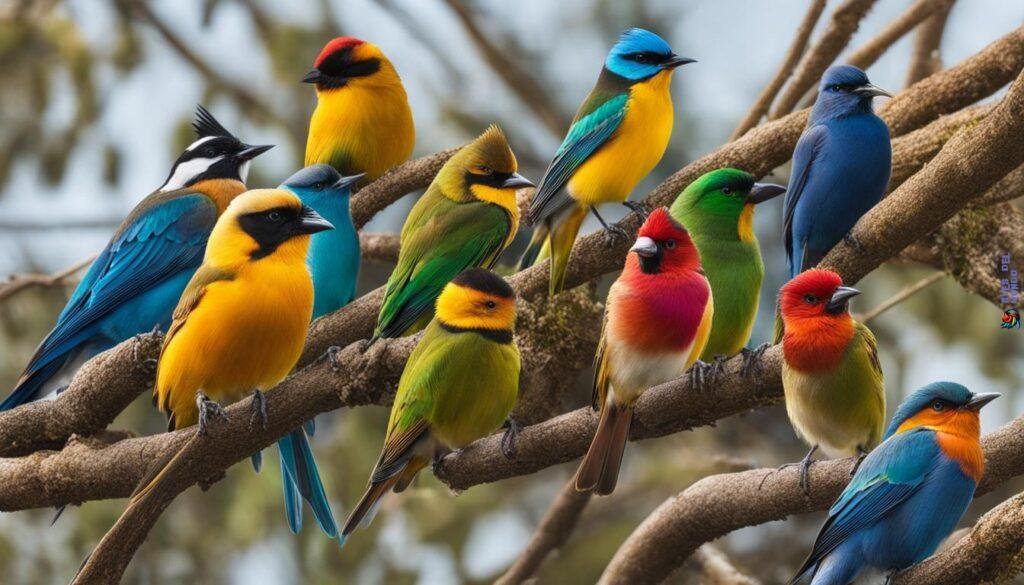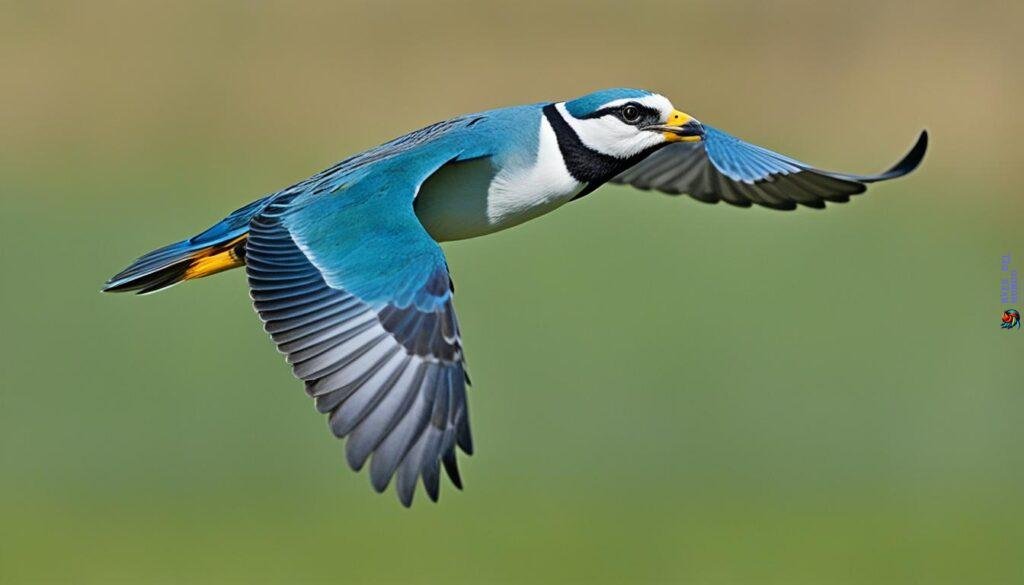Did you know that there are over 10,000 different species of birds worldwide? From the majestic bald eagle to the tiny hummingbird, the avian world is teeming with diverse bird types, each uniquely adapted to their specific habitats.
Birds can be found in a wide range of habitats, from lush forests to arid grasslands and from coastal wetlands to urban environments. Their ability to thrive in different habitats showcases the incredible adaptability and diversity of these fascinating creatures.
In this article, we will explore the importance of habitat in bird identification, the impact of different habitat types on bird diversity, and the crucial role of habitat conservation in preserving bird populations. So whether you’re a birdwatching enthusiast or simply curious about the vast array of bird species in the world, join us on this journey to discover the various bird types across habitats.
Bird Identification: The Importance of Habitat
When it comes to bird identification, understanding the importance of habitat is key. Birds are highly adapted to their specific environments, and different habitats attract distinct bird species. By observing the habitat where a bird is found, birdwatchers can use this information, along with other identifying characteristics like size, shape, color pattern, and behavior, to accurately determine the species.
Habitat cues play a crucial role in distinguishing bird types. Each habitat has unique characteristics that attract certain bird species. For example, forested habitats are often home to woodland birds, while open grasslands are frequented by meadowlarks and other grassland species. By recognizing the habitat cues, birdwatchers can narrow down the potential identification options and focus their efforts on specific bird species that are likely to be present.
«The variety of bird species across different habitats provides birdwatchers with endless opportunities to practice their identification skills and explore the diverse avian world.»
While habitat is just one aspect of bird identification, it provides valuable context that significantly aids in narrowing down potential species. By paying attention to the surrounding environment and the specific habitat characteristics, you can enhance your ability to identify birds accurately during your birdwatching ventures.

Exploring Bird Diversity in Different Habitats
The diversity of bird species varies across different habitats, with each habitat type playing a crucial role in promoting bird diversity. Studies have shown that certain habitats, such as forestland, farmland, grassland, and freshwater wetlands, exhibit higher levels of species richness and evenness.
Species richness refers to the number of different bird species present in a particular habitat, while species evenness refers to the relative abundance of each species within that habitat.
Forestland habitats, comprising both coniferous and deciduous forests, have been found to harbor a wide range of bird species. The complex structure of these forests provides abundant food resources, nesting sites, and shelter, making them conducive to supporting diverse bird populations.
Farmlands, including agricultural fields and crop lands, also contribute significantly to bird diversity. The varied landscape, crop rotation practices, and presence of hedgerows or set-aside areas create a mosaic of habitats that attracts different bird species. These habitats often provide ample foraging opportunities and nesting sites.
Grasslands act as vital habitats for many bird species, particularly those adapted to open spaces and ground-nesting habits. Native grasslands, with their diverse plant communities and insect populations, support a range of grassland-dependent birds. However, human activities such as urbanization and intensive agriculture have led to the decline of grassland habitats, resulting in a decrease in bird diversity in these areas.
Freshwater wetlands, including marshes, swamps, and ponds, provide essential breeding and foraging grounds for numerous bird species. The rich food resources, diverse vegetation, and water availability in these habitats attract waterbirds, shorebirds, and other wetland-dependent species. Wetlands are also important stopover sites during migration, supporting a diverse range of bird species during their journeys.
While natural habitats tend to promote higher bird diversity, the same cannot be said for urban greenspaces. Urbanization and habitat fragmentation often lead to the loss of native vegetation, reducing the suitability of these spaces for supporting diverse bird populations. However, efforts can be made to create bird-friendly urban environments through the inclusion of native plants, water features, and appropriate habitat management practices.
Understanding the relationship between habitat types and bird diversity is crucial for promoting and conserving bird populations. By prioritizing the conservation and restoration of key habitat types that support high species richness and evenness, we can ensure the preservation of a diverse array of bird species and their ecosystem services.
The Impact of Habitat Types on Bird Diversity
Different habitat types have varying effects on bird diversity. The table below provides an overview of the impact of different habitats on bird species richness and evenness.
| Habitat Type | Species Richness | Species Evenness |
|---|---|---|
| Forestland | High | High |
| Farmland | High | Moderate |
| Grassland | Moderate | Moderate |
| Freshwater Wetlands | High | High |
| Urban Greenspaces | Low | Low |
The data in the table highlights the positive correlation between forestland, farmland, and freshwater wetlands with both species richness and evenness. These habitats provide favorable conditions for supporting a diverse range of bird species.
Grasslands, while supporting a moderate level of species richness and evenness, are vital for the survival of grassland-dependent bird species. However, the loss and degradation of grassland habitats pose a significant threat to bird populations that depend on these areas.
In contrast, urban greenspaces, due to habitat fragmentation and the presence of non-native plant species, tend to have lower levels of bird diversity. However, proactive urban planning and habitat management can help create urban environments that support higher levels of bird diversity.
By understanding the impact of habitat types on bird diversity, conservation efforts can be targeted towards preserving and restoring critical habitats that promote bird diversity and ensure the long-term survival of diverse bird populations.
Predicting Bird Diversity in Various Habitats
When it comes to understanding bird diversity in different types of habitats, there is still much research to be done. Numerous factors influence the composition of bird species within a particular habitat, including landscape habitat types, their overall composition, and various characteristics. These factors play a crucial role in predicting the diversity of bird species in a given habitat.
Studies have shown that forests, particularly coniferous and mixed tree forests, have a significant impact on promoting higher species richness and evenness. The dense vegetation and variety of resources found in forest habitats provide a favorable environment for a wide range of bird species to thrive. Forests offer ample nesting opportunities, shelter, and a diverse food supply, making them attractive to many bird species.
Similarly, certain farmland-related habitats and natural habitats have positive effects on bird diversity. Farmland habitats, such as fields and agricultural areas, provide both open spaces for certain bird species and the presence of insect populations, attracting insectivorous birds. Natural habitats, such as wetlands and grasslands, also harbor diverse bird communities due to the availability of suitable nesting sites and food sources.
The Role of Landscape Habitat Types
The diversity of bird species in a particular habitat is strongly influenced by the specific landscape habitat type. Different landscape habitat types offer unique characteristics and resources that attract specific bird species. Understanding these landscape habitat types is key to predicting and preserving bird diversity.
Let’s take a closer look at some common landscape habitat types and their impact on bird diversity:
| Landscape Habitat Type | Key Characteristics | Effect on Bird Diversity |
|---|---|---|
| Forestland | Dense vegetation, variety of tree species | Positive effect, promotes higher species richness and evenness |
| Farmland | Open spaces, availability of insect populations | Positive effect, attracts diverse bird communities |
| Wetlands | Water bodies, aquatic plants, abundant food resources | Positive effect, supports diverse bird species |
| Grasslands | Open grassy areas, short woody vegetation | Positive effect, provides suitable nesting sites for various bird species |
By analyzing the composition of these landscape habitat types and understanding their specific characteristics, researchers can make informed predictions about the diversity of bird species in various habitats.

More research is needed to gain a comprehensive understanding of the complex interplay between landscape habitat types and bird diversity. By identifying key factors and studying their influence on bird species composition, we can better predict and manage bird populations in different habitats.
It is important to note that the prediction of bird diversity is a challenging task due to the dynamic nature of habitats and the ever-changing environmental conditions. Nonetheless, by continuously studying landscape habitat types and their influence on bird communities, we can enhance our understanding of how to support and protect bird diversity.
The Relationship Between Habitat Types and Bird Numbers
Different habitat types have a significant impact on bird numbers and abundance. The presence of specific habitats can attract or deter certain bird species, leading to variations in bird populations across different habitats.
Forestland, with the exception of windbreak forests, has been found to decrease bird numbers. The dense canopy and limited understory of mature forests create a less suitable environment for many bird species.
On the other hand, grasslands, freshwater wetlands, farmlands, aquaculture ponds, and building areas play a vital role in increasing bird numbers. These habitats offer open spaces, diverse food sources, and nesting opportunities, attracting a wide range of bird species.
It is interesting to note that bird abundance varies depending on the habitat type. For example, grasslands support a higher density of ground-nesting bird species, while wetlands provide a critical habitat for waterfowl and migratory birds.
By understanding the relationship between habitat types and bird numbers, researchers, conservationists, and bird enthusiasts can work together to protect and manage these habitats effectively.
| Habitat Type | Effect on Bird Numbers |
|---|---|
| Forestland | Decreases bird numbers |
| Grassland | Increases bird numbers |
| Freshwater Wetland | Increases bird numbers |
| Farmland | Increases bird numbers |
| Aquaculture Ponds | Increases bird numbers |
| Building Areas | Increases bird numbers |
In conclusion, understanding the relationship between habitat types and bird numbers is crucial for conservation efforts and maintaining healthy bird populations. By preserving and creating diverse habitats, we can support and enhance bird abundance in our surroundings.

Impact of Habitat Sub-Types on Bird Diversity
Different habitat sub-types within broader habitat categories can have varying impacts on bird diversity. Understanding the specific characteristics of these habitat sub-types is crucial in predicting and conserving bird diversity. Let’s explore some examples of how different habitat sub-types affect bird species richness and evenness.
Forestland Sub-Types
Within forestland, certain sub-types, such as conifer forests and bamboo forests, have shown to increase bird species richness and evenness. These dense and diverse forests provide ample food sources, nesting sites, and cover, attracting a wide range of bird species. Here’s an example of the impact of forestland sub-types on bird diversity:
| Habitat Sub-Type | Impact on Bird Species Richness | Impact on Bird Evenness |
|---|---|---|
| Conifer Forests | High | High |
| Bamboo Forests | High | High |
Tall Grasslands and Orchards
In addition to forestland, other habitat sub-types such as tall grasslands and orchards also have a positive impact on bird species richness and evenness. These open habitats provide suitable foraging areas, breeding grounds, and nesting sites for various bird species. Here’s an example of how these habitat sub-types influence bird diversity:
| Habitat Sub-Type | Impact on Bird Species Richness | Impact on Bird Evenness |
|---|---|---|
| Tall Grasslands | High | High |
| Orchards | High | High |
Different habitat sub-types have unique characteristics that attract specific bird species. By understanding the impact of these sub-types on bird diversity, conservation efforts can be better directed towards preserving and enhancing diverse habitats for the benefit of bird populations.

The Importance of Forest Habitats for Bird Diversity
Forest habitats play a crucial role in promoting bird diversity. Studies have shown that the presence of forests, including coniferous and mixed tree forests, has a positive impact on bird species richness and evenness. Forests provide the necessary food, shelter, and nesting opportunities for a wide range of bird species, making them important habitats for maintaining healthy bird populations.
The dense foliage of forest habitats offers protection from predators and harsh weather conditions, creating a safe haven for birds to thrive. The variety of tree species within forests provides an abundance of food sources, such as fruits, nuts, and insects, catering to the diverse dietary needs of different bird species.
Furthermore, the vertical structure of forests, with multiple layers of vegetation ranging from the forest floor to the canopy, offers a variety of niches for birds. This allows for the coexistence of different bird species, promoting bird evenness within the habitat.
Forest habitats also serve as important nesting sites for many bird species. The availability of suitable nesting locations, such as tree cavities, branches, and dense shrubs, contributes to successful reproduction and the growth of bird populations.
«Forests are not only beautiful, but they also provide a haven for a diverse range of bird species. Their intricate ecosystem supports a web of interactions that ensures the survival of these magnificent creatures.» – John James, Ornithologist
Conservation efforts aimed at preserving and restoring forest habitats are essential to safeguarding bird diversity. These efforts involve measures such as sustainable forestry practices, protection of old-growth forests, and reducing habitat fragmentation caused by human activities.
The positive impact of forest habitats on bird diversity highlights the importance of recognizing and protecting these valuable ecosystems. By promoting bird species richness and enhancing bird evenness, forests contribute significantly to the overall health and stability of bird populations.

Non-Forest Habitats and Bird Diversity
Non-forest habitats play a significant role in supporting bird diversity alongside forested habitats. While forests are known for their rich bird populations, non-forest habitats like grasslands, scrub, and shrub habitats have their own contributions to bird species richness.
These non-forest habitats typically feature a single-layered canopy and shorter undergrowth compared to dense forest environments. Their unique characteristics attract specific bird species that are adapted to thrive in such conditions, thereby adding to the overall bird diversity within the ecosystem.
Research has shown that non-forest habitats can positively impact bird species richness, providing a variety of niches for different bird species to occupy. For example, grasslands may be preferred by ground-nesting birds, while scrub habitats might offer suitable habitat for bird species that require dense cover for nesting and foraging.
However, it’s important to note that the impact of non-forest habitats on bird evenness, which refers to the balance or distribution of bird species within a habitat, may vary depending on the specific characteristics of each non-forest habitat. Factors such as vegetation structure, food availability, and the presence of predators can influence the evenness of bird species within these habitats.

Examples of Non-Forest Habitats and Their Impact on Bird Diversity:
| Non-Forest Habitat | Impact on Bird Species Richness | Impact on Bird Evenness |
|---|---|---|
| Grasslands | Attracts a diverse range of ground-nesting bird species | Varies depending on grassland management practices and predator presence |
| Scrub Habitats | Provides abundant cover for bird species that require dense vegetation for nesting and foraging | Dependent on vegetation structure and resource availability |
| Shrub Habitats | Offers suitable habitat for bird species seeking cover and nesting sites | May depend on the diversity and density of shrub species present |
These non-forest habitats, with their unique characteristics and their ability to support specific bird species, contribute to the overall diversity and complexity of bird habitats. Conservation efforts should consider the importance of non-forest habitats alongside forested habitats to ensure the preservation of bird diversity and the maintenance of healthy bird populations across various ecosystems.
Aquatic Habitats and Bird Diversity
Aquatic habitats, such as lakes, ponds, swamps, and coastlines, provide unique environments for bird species. These habitats support a wide variety of bird species that rely on water for food, shelter, and reproduction. The presence of water bodies offers abundant food sources in the form of fish, insects, and aquatic plants, attracting various bird species.
Wetlands, in particular, play a significant role in maintaining healthy bird populations and promoting bird species richness. Wetlands are characterized by diverse plant and animal communities and often serve as breeding and nesting grounds for many bird species. The marshes, mudflats, and shallow waters of wetlands provide suitable habitats for waterfowl, waders, and other water-dependent bird species.
Wetlands are crucial for birds as they provide a range of essential resources, including food, nesting sites, and protection from predators. They contribute to the overall biodiversity by supporting a wide variety of bird species and other wildlife.
The impact of aquatic habitats on bird species richness is significant. Birds found in aquatic habitats include waterfowl, such as ducks, geese, and swans; wading birds, such as herons and egrets; and shorebirds, such as sandpipers and plovers. The diverse range of bird species in these habitats contributes to overall bird diversity in different ecosystems.
The Importance of Wetlands for Bird Populations
Wetlands are especially important for bird populations due to the critical functions they serve and the services they provide. Wetlands act as natural filters, improving water quality and preventing soil erosion. They also function as flood control systems, absorbing excess water and reducing the risk of flooding.
Furthermore, wetlands are essential staging areas for migratory bird species. They provide crucial stopover sites for birds during their long-distance journeys, allowing them to rest and refuel before continuing their migration. Many bird species rely on these habitats to complete their annual migratory routes.
The conservation of aquatic habitats and wetlands is crucial for preserving bird diversity, supporting healthy bird populations, and maintaining the overall balance of ecosystems.

| Common Bird Species in Aquatic Habitats | Characteristics |
|---|---|
| Mallard | Anas platyrhynchos |
| Great Blue Heron | Ardea herodias |
| Pied-billed Grebe | Podilymbus podiceps |
| American Coot | Fulica americana |
| Black-crowned Night-Heron | Nycticorax nycticorax |
The Role of Habitat in Migration
Bird migration is a fascinating phenomenon that involves the seasonal movement of birds from one location to another. Throughout their annual cycle, birds rely on different habitats for various activities during migration, including resting, feeding, and refueling.
During their long and challenging journeys, migrating birds depend on specific habitats to provide crucial resources and support their survival. These habitats are known as migratory habitats and play a vital role in facilitating successful migration.
Understanding the importance of different habitats in migration is key to studying bird populations and implementing effective conservation measures. By identifying and protecting critical migratory stopover habitats, we can safeguard the well-being of bird populations and promote their long-term survival.
Migratory habitats vary depending on the species and their specific migration routes. For example, coastal areas, wetlands, and open grasslands are crucial for shorebirds during their migration. Forests and woodlands provide essential stopover sites for songbirds, while coastal and marine habitats are vital for seabirds.

Impact on Bird Populations during Migration
Migratory habitats directly influence bird populations by providing critical resources for fueling flights, rest, and refueling. These habitats ensure that birds have suitable conditions to recover their energy stores, replenish fat reserves, and continue their arduous journeys.
Changes or disruptions in migratory habitats can have significant consequences for bird populations. Habitat loss, degradation, and fragmentation due to human activities, climate change, and other factors can disrupt crucial stopover sites and food sources, negatively impacting the survival and reproductive success of migrating birds.
The Importance of Conservation
Conservation efforts should prioritize the preservation and restoration of migratory habitats to support bird populations during their migration. Targeted initiatives can include creating protected areas, implementing sustainable land management practices, and raising awareness about the importance of migratory habitats.
| Migratory Habitat | Key Species | Threats |
|---|---|---|
| Coastal Areas | Shorebirds, waterfowl, seabirds | Coastal development, pollution, habitat destruction |
| Wetlands | Migratory waterbirds, wading birds | Wetland drainage, pollution, habitat degradation |
| Forest and Woodlands | Songbirds, raptors | Habitat loss, deforestation, fragmentation |
| Open Grasslands | Grassland birds, raptors | Agricultural intensification, habitat conversion |
| Marine and Coastal | Seabirds, waterbirds, shorebirds | Overfishing, pollution, habitat degradation |
Protecting migratory habitats not only benefits bird populations but also contributes to the overall health and functioning of ecosystems. By preserving these habitats, we can help maintain biodiversity, support essential ecological processes, and ensure the continued enjoyment of birdwatching and other nature-based activities for future generations.
Micro-habitats: Small-Scale Habitat Variations
Micro-habitats are fascinating ecological niches within larger habitats that exhibit small-scale variations in environmental conditions and resources. These variations can include differences in soil composition, moisture levels, light exposure, and the presence of specific plant species or communities. Bird species have demonstrated remarkable adaptation to these micro-habitats, developing unique strategies to thrive in their specialized environments.
Within a forest ecosystem, for example, micro-habitats such as tree cavities, fallen logs, and dense foliage provide shelter and nesting opportunities for cavity-nesting birds, like woodpeckers and owls. Similarly, smaller-scale variations in wetland habitats, such as reed beds, ponds, and marshy areas, attract marsh-dwelling bird species like herons, rails, and bitterns.
Micro-habitats not only support specialized bird species but also contribute to the overall diversity and complexity of bird habitats. They create pockets of distinct environmental conditions within larger habitats, allowing different bird species to coexist and utilize specific resources. This enhances the richness and variety of bird populations found within a given habitat.
One example of micro-habitats supporting unique bird species is the rocky outcrops found within grassland habitats. These small-scale variations in terrain provide ideal nesting sites and foraging opportunities for cliff-dwelling bird species such as peregrine falcons and rock wrens. The rocky crevices and ledges offer protection against predators and access to prey items that thrive in this unique micro-environment.

Specialized Adaptations to Micro-habitats
Birds that have adapted to micro-habitats often possess specialized physical and behavioral traits that enable them to exploit the available resources effectively. These adaptations may include:
- Camouflage or cryptic coloration that allows birds to blend seamlessly into their micro-habitat, providing protection against predators and increasing hunting success.
- Morphological features that enable birds to navigate unique physical structures within micro-habitats, such as long bills for probing flowers or slender beaks for accessing insect prey in narrow crevices.
- Acute sensory capabilities, including enhanced hearing or vision, that allow birds to detect prey, mates, or competitors in visually complex or acoustically challenging micro-habitats.
- Behavioral adaptations such as specialized feeding techniques, nesting behaviors, or vocalizations tailored to the specific micro-habitat conditions.
The presence of micro-habitats within larger habitats contributes to the overall biodiversity and resilience of ecosystems. Protecting and conserving these smaller-scale variations is crucial for maintaining healthy bird populations and preserving the intricate relationships between birds and their habitat.
Factors Influencing Bird Habitat Choice
When it comes to choosing their habitats, birds are influenced by a multitude of factors. These factors can be categorized into two main groups: direct and indirect factors. Understanding these influences is crucial for bird enthusiasts and researchers alike. Let’s explore the key factors that shape bird habitat choice.
Influence of Indirect Factors
Indirect factors play a significant role in a bird’s ability to find food and shelter efficiently. These factors are inherent to the bird’s biology and behavior. For example, a bird’s morphology, such as the shape and size of its beak, determines its feeding preferences. Similarly, behavior, such as feeding strategies and nesting habits, also influences the habitats birds choose.
Influence of Direct Factors
Direct factors refer to the specific characteristics of a habitat that directly impact a bird’s ability to thrive in that environment. These factors can include the vegetation structure, topography, presence of water bodies, and availability of food sources. Birds select habitats with features that match their needs, preferences, and survival requirements.
Influence of Habitat Characteristics
Habitat characteristics play a crucial role in bird habitat choice. Different species have specific preferences regarding vegetation density, canopy cover, and understory composition. For example, some birds prefer open habitats with sparse vegetation, while others thrive in dense forests. Understanding these habitat characteristics is essential for identifying potential bird species in a given habitat.
Influence of Species Interactions
Species interactions, such as competition and cooperation, also influence bird habitat choice. Birds may seek habitats where they can find suitable food and nesting resources without intense competition from other species. Additionally, certain bird species may rely on cooperative behavior, such as flocking or mixed-species foraging, leading them to select habitats where they can engage in these interactions.
| Factors | Description |
|---|---|
| Indirect Factors | Innate bird morphology and behavior |
| Direct Factors | Habitat characteristics (vegetation, topography, water bodies, food sources) |
| Habitat Characteristics | Vegetation density, canopy cover, understory composition |
| Species Interactions | Competition and cooperation |
Understanding the factors that influence bird habitat choice is essential for birdwatchers, conservationists, and researchers. By considering these factors, we can gain insights into bird behavior, aid in habitat conservation efforts, and better appreciate the complex dynamics of bird habitats.
Importance of Habitat Conservation for Bird Diversity
Habitat conservation plays a critical role in preserving bird diversity and maintaining the overall health of bird populations. By protecting critical habitats, such as forests, wetlands, and other key habitat types, we ensure the survival of diverse bird species and their ecosystems.
Efforts should be focused on habitat restoration, reducing habitat loss, and minimizing fragmentation. Restoring degraded habitats and rehabilitating damaged areas can provide essential resources and nesting opportunities for a wide range of bird species.
Implementing effective conservation measures is crucial for prioritizing the needs of different bird species and their specific habitat requirements. This includes safeguarding nesting sites, providing adequate food sources, and maintaining suitable migration stopover points. By taking these steps, we can foster thriving bird populations and ensure the long-term sustainability of bird diversity.



